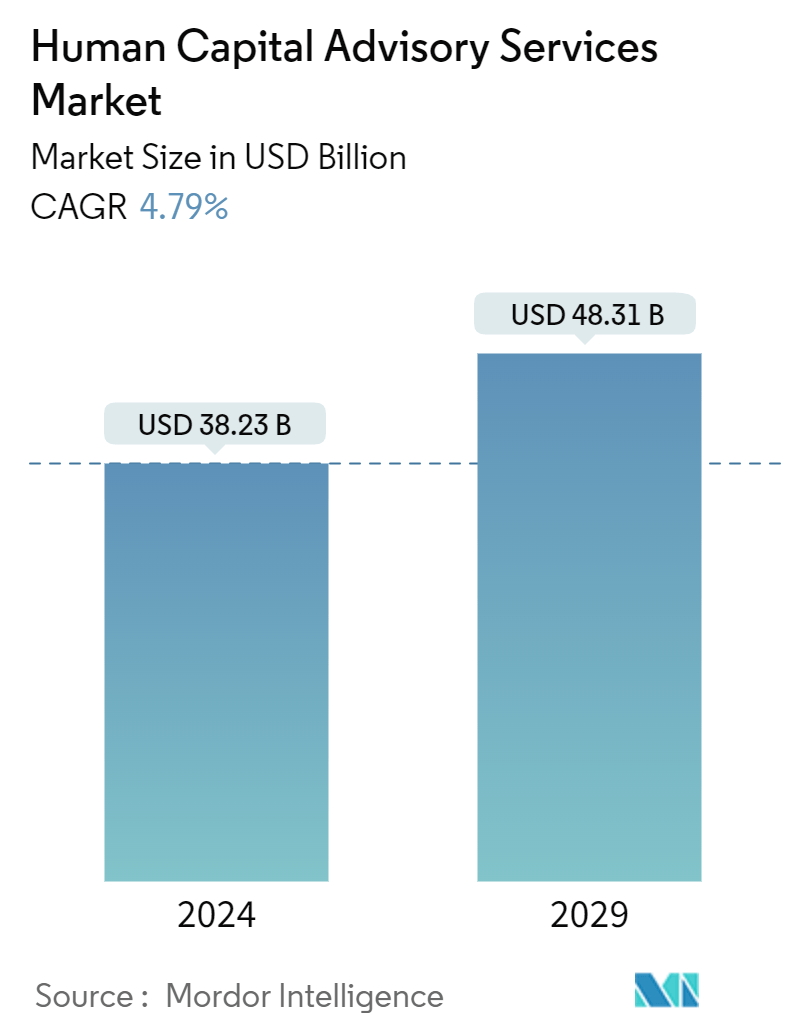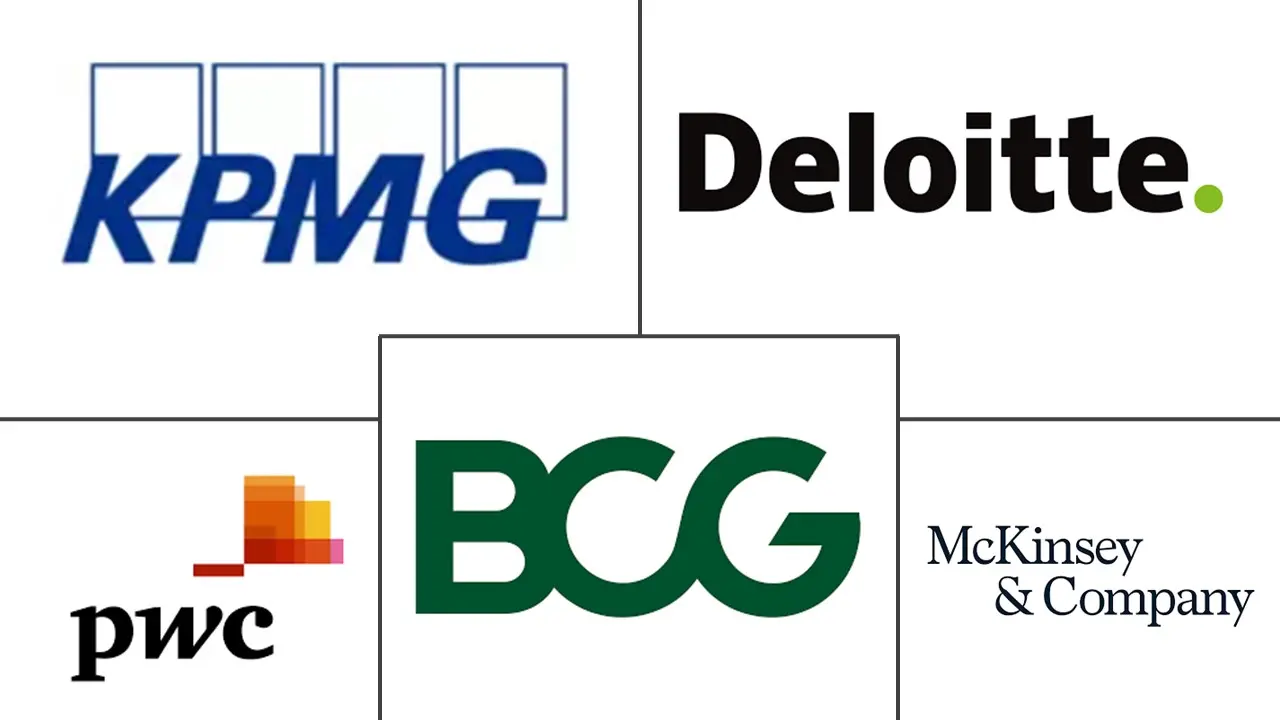Market Size of Human Capital Advisory Services Industry

| Study Period | 2019 - 2029 |
| Market Size (2024) | USD 38.23 Billion |
| Market Size (2029) | USD 48.31 Billion |
| CAGR (2024 - 2029) | 4.79 % |
| Fastest Growing Market | Asia Pacific |
| Largest Market | Europe |
Major Players
*Disclaimer: Major Players sorted in no particular order |
Human Capital Advisory Services Market Analysis
The Human Capital Advisory Services Market size is estimated at USD 38.23 billion in 2024, and is expected to reach USD 48.31 billion by 2029, growing at a CAGR of 4.79% during the forecast period (2024-2029).
- The growth of the HR advisory market is influenced by various macro and micro factors. For instance, Economic growth often leads to business expansions, increasing the demand for HR advisory services. Conversely, economic downturns drive demand as companies seek to optimize their workforce and reduce costs.
- Moreover, a heightened focus on talent management and retention in competitive labor markets raises the demand for HR advisory. The rise in remote work and the gig economy necessitates new HR strategies and policies. Changes in labor laws, such as minimum wage adjustments, healthcare mandates, and diversity requirements, also impact the market. Adopting HR technologies like AI, HR analytics, and automation tools requires specialized advisory services.
- An increase in employment rates directly drives demand for HR advisory services. For instance, as organizations expand their workforce, they require substantial talent management strategies to attract, retain, and nurture top talent. HR advisors specialize in performance management, career development, and succession planning.
- Moreover, as companies scale, they often require organizational restructuring or the creation of new frameworks to support their growing staff. In such scenarios, HR advisory services are pivotal, offering insights into organizational design, change management, and cultural integration.
- There are various technological trends that are expected to drive the market. For example, Data analysis assists HR in managing the entire talent lifecycle by looking into competitive benchmarking, competency gap analysis, learning opportunities, workforce patterns, talent demands, etc. The human resource function is expanding from both a technological and an analytics perspective.
- For instance, in May 2024, PeopleStrong, an HR and payroll tech company, teamed up with Google Cloud in a strategic move to drive HR transformation and innovation across Asian businesses. This partnership will see the integration of Google Cloud's advanced AI tools, such as Vertex AI and Gemini models, into PeopleStrong's already robust HR tech platform. PeopleStrong's HR Tech 4.0 platform stands out as India's pioneer HR tech solution, leveraging advanced Generative AI. Boasting over 2,200 open APIs, the platform fosters a seamless HR ecosystem, enhancing employee experiences and administrative efficiency.
- On the contrary, Market growth faces a challenge with the rising reliance on outsourcing agencies. This market involves companies delegating their HR functions to external service providers. Businesses can streamline HR tasks, cut costs, boost efficiency, and lighten their administrative load. Yet, entrusting agencies with critical functions like performance management and employee feedback risks ceding control and could spark employee discontent. While outsourcing HR can bring specialized skills and scalability, it's particularly beneficial for industries such as IT and hospitality.
Human Capital Advisory Services Industry Segmentation
The scope of the study focuses on the market analysis of human capital advisory across the globe, and market size tracks the demand for human capital advisory services offered by various market players operating in the market. Human capital advisory services encompass HR outsourcing (managed services), consulting, and learning and development. The analysis is based on the market insights captured through primary and secondary research.
The human capital advisory market is segmented by service type (HR outsourcing (HR managed services), HR consulting [organizational change and development, employee management, compliance and ethics, HR transformation, culture and change, others], and learning and development), by Organization Size (SMEs and large enterprises), by end user (information technology, healthcare, BFSI, industrial and manufacturing, and others), and by geography (North America, Europe, Asia Pacific, Latin America, Middle East and Africa). The market sizes and forecasts are provided in terms of value (USD) for all the above segments.
| By Service Type | ||||||||
| HR Outsourcing | ||||||||
| ||||||||
| Learning and Development |
| By Organization Size | |
| SMEs | |
| Large Enterprise |
| By End Users | |
| Information Technology | |
| Healthcare | |
| BFSI | |
| Industrial and Manufacturing | |
| Others |
| By Geography*** | |
| North America | |
| Europe | |
| Asia | |
| Australia and New Zealand | |
| Latin America | |
| Middle East and Africa |
Human Capital Advisory Services Market Size Summary
The Human Capital Advisory Services Market is poised for significant growth, driven by a combination of macroeconomic factors and evolving business needs. As organizations expand and adapt to competitive labor markets, the demand for specialized HR advisory services is increasing. This demand is further fueled by the rise of remote work, the gig economy, and the need for compliance with changing labor laws. Companies are increasingly turning to HR technologies, such as AI and analytics, to enhance their talent management strategies, necessitating expert advisory services to navigate these advancements. The market is characterized by a diverse range of players, including major consulting firms, who are leveraging partnerships and technological integrations to enhance their service offerings and maintain a competitive edge.
In Europe, the human capital advisory market is experiencing robust growth as businesses recognize the strategic importance of effective employee management and organizational development. The market is benefiting from technological innovations and strategic partnerships that enhance HR capabilities across various sectors. Small and medium-sized enterprises (SMEs) are particularly reliant on these advisory services to overcome challenges related to technology integration and HR transformation. Despite the potential benefits of outsourcing HR functions, companies must balance efficiency with the need for control over critical HR processes. Overall, the market is expanding as organizations seek to optimize their human resources to achieve sustainable growth and competitive advantage in a rapidly changing economic landscape.
Human Capital Advisory Services Market Size - Table of Contents
-
1. MARKET INSIGHTS
-
1.1 Market Overview
-
1.2 Industry Attractiveness - Porter's Five Forces Analysis
-
1.2.1 Bargaining Power of Suppliers
-
1.2.2 Bargaining Power of Buyers
-
1.2.3 Threat of New Entrants
-
1.2.4 Degree of Competition
-
1.2.5 Threat of Substitutes
-
-
-
2. MARKET SEGMENTATION
-
2.1 By Service Type
-
2.1.1 HR Outsourcing
-
2.1.2 HR Consulting
-
2.1.2.1 Organizational Change and Development
-
2.1.2.2 Employee Management
-
2.1.2.3 Compliance and Ethics
-
2.1.2.4 HR Transformation
-
2.1.2.5 Culture and Change
-
2.1.2.6 Others
-
-
2.1.3 Learning and Development
-
-
2.2 By Organization Size
-
2.2.1 SMEs
-
2.2.2 Large Enterprise
-
-
2.3 By End Users
-
2.3.1 Information Technology
-
2.3.2 Healthcare
-
2.3.3 BFSI
-
2.3.4 Industrial and Manufacturing
-
2.3.5 Others
-
-
2.4 By Geography***
-
2.4.1 North America
-
2.4.2 Europe
-
2.4.3 Asia
-
2.4.4 Australia and New Zealand
-
2.4.5 Latin America
-
2.4.6 Middle East and Africa
-
-
Human Capital Advisory Services Market Size FAQs
How big is the Human Capital Advisory Services Market?
The Human Capital Advisory Services Market size is expected to reach USD 38.23 billion in 2024 and grow at a CAGR of 4.79% to reach USD 48.31 billion by 2029.
What is the current Human Capital Advisory Services Market size?
In 2024, the Human Capital Advisory Services Market size is expected to reach USD 38.23 billion.

